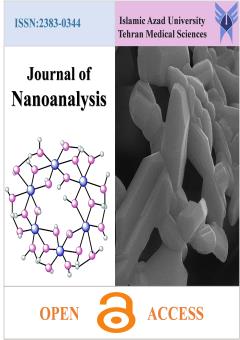Amide‑functionalized metal-organic frameworks Cu3 (BTC) 2 as a new platform for efficient and selective removal of Cd (II) from aqueous solutions
Subject Areas : Journal of Nanoanalysismaryam karimi 1 * , Tolou Pourashraf 2
1 - دانشگاه ازاد اسلامی واحد علوم و تحقیقات تهران
2 - Department of Applied Chemistry, Faculty of Pharmaceutical Chemistry, Tehran Medical Sciences, Islamic Azad University, Tehran, Iran
Keywords: amine-functionalized MOF, heavy metal, removal of Cd (II), post-synthetic modification,
Abstract :
This contribution indicated how to anchor amine-decorated pores of Cu-MOF, Cu3 (BTC)2 (1), formulated Cu3(BTC)2@AMT (1@AMT) (where AMT=2-amino-5-mercapto-4,3,1-thiadiazole and BTC=1,3,5-benzenetricarboxlic acid or trimesic acid) as an efficient way to remove Cd (II) from an aqueous solution. Furthermore, the post-synthetic modification as exemplified in the context of functionalizing the MOF, 1 with AMT was performed, and the resultant structure was determined through X-ray Powder diffraction (XRPD), FTIR spectroscopy, and field emission scanning electron microscopy (FESEM). N2 adsorption-desorption by Brunauer-Emmett-teller (BET) has been determined to evaluate the specific surface area (7.49 m2.g-1) and the pore volume (0.04 cm3.g-1) of the sample. Herein, we study the effect of various crucial factors, including pH, contact time, and other background metal ions, on 1@AMT uptake capacity. Moreover, the reusability was studied and recycled without considerable loss of Cd (II) uptake capacity during five cycles. The resultant amine-functionalized MOF, 1@AMT, showed a high Cd (II) uptake capacity of 692.3 mg.g-1, surpassing that of the benchmark adsorbents. Our work thus paves the way for developing functionalized MOFs with significant affinity between the amide group and Cd (II) as a new type of platform with sufficient cadmium removal performance.
1- Qiu S, Zhu G. Molecular engineering for synthesizing novel structures of metal–organic frameworks with multifunctional properties. Coordination Chemistry Reviews. 2009;253(23-24):2891-911.
2- Gao Q, Xu J, Bu X-H. Recent advances about metal–organic frameworks in the removal of pollutants from wastewater. Coordination Chemistry Reviews. 2019;378:17-31.
3- Khan Z, Elahi A, Bukhari DA, Rehman A. Cadmium sources, toxicity, resistance and removal by microorganisms-A potential strategy for cadmium eradication. Journal of Saudi Chemical Society. 2022;26(6):101569.
4- Iqbal K, Yahya S, Jadoon M, Yaseen E, Nadeem Z. Strategies for cadmium remediation in nature and their manipulation by molecular techniques: a comprehensive review. International Journal of Environmental Science and Technology. 2024:1-18.
5- Navaei Diva T, Zare K, Taleshi F, Yousefi M. Synthesis, characterization, and application of nickel oxide/CNT nanocomposites to remove Pb 2+ from aqueous solution. Journal of Nanostructure in Chemistry. 2017;7:273-81.
6- Xu G-R, An Z-H, Xu K, Liu Q, Das R, Zhao H-L. Metal organic framework (MOF)-based micro/nanoscaled materials for heavy metal ions removal: The cutting-edge study on designs, synthesis, and applications. Coordination Chemistry Reviews. 2021;427:213554.
7- Behbahani ES, Dashtian K, Ghaedi M. Fe3O4-FeMoS4: Promise magnetite LDH-based adsorbent for simultaneous removal of Pb (II), Cd (II), and Cu (II) heavy metal ions. Journal of hazardous materials. 2021;410:124560.
8- Pishnamazi M, Koushkbaghi S, Hosseini SS, Darabi M, Yousefi A, Irani M. Metal organic framework nanoparticles loaded-PVDF/chitosan nanofibrous ultrafiltration membranes for the removal of BSA protein and Cr (VI) ions. Journal of Molecular Liquids. 2020;317:113934.
9- Kitagawa S. Metal–organic frameworks (MOFs). Chemical Society Reviews. 2014;43(16):5415-8.
10- Fan M, Zhang P, Wang C, Sun H. Highly efficient removal of ionic dyes in aqueous solutions using magnetic 3D reduced graphene oxide aerogel supported nano zero-valent iron. Environmental Engineering Research. 2024;29(1).
11- Ge F, Li M-M, Ye H, Zhao B-X. Effective removal of heavy metal ions Cd2+, Zn2+, Pb2+, Cu2+ from aqueous solution by polymer-modified magnetic nanoparticles. Journal of hazardous materials. 2012;211:366-72.
12- Silva FA, Pissetti FL. Adsorption of cadmium ions on thiol or sulfonic-functionalized poly (dimethylsiloxane) networks. Journal of colloid and interface science. 2014;416:95-100.
13- An F, Gao B, Dai X, Wang M, Wang X. Efficient removal of heavy metal ions from aqueous solution using salicylic acid type chelate adsorbent. Journal of hazardous materials. 2011;192(3):956-62.
14- Xu M, Zhang Y, Zhang Z, Shen Y, Zhao M, Pan G. Study on the adsorption of Ca2+, Cd2+ and Pb2+ by magnetic Fe3O4 yeast treated with EDTA dianhydride. Chemical Engineering Journal. 2011;168(2):737-45.
15- Dubey A, Mishra A, Singhal S. Application of dried plant biomass as novel low-cost adsorbent for removal of cadmium from aqueous solution. International journal of environmental science and technology. 2014;11:1043-50.
16- Chakraborty R, Asthana A, Singh AK, Jain B, Susan ABH. Adsorption of heavy metal ions by various low-cost adsorbents: a review. International Journal of Environmental Analytical Chemistry. 2022;102(2):342-79.
17- Chen C-Y, Chiang C-L, Huang P-C. Adsorptions of heavy metal ions by a magnetic chelating resin containing hydroxy and iminodiacetate groups. Separation and purification technology. 2006;50(1):15-21.
18- Yalçınkaya Ö, Kalfa OM, Türker AR. Chelating agent free-solid phase extraction (CAF-SPE) of Co (II), Cu (II) and Cd (II) by new nano hybrid material (ZrO2/B2O3). Journal of hazardous materials. 2011;195:332-9.
19- Wang Y, Ye G, Chen H, Hu X, Niu Z, Ma S. Functionalized metal–organic framework as a new platform for efficient and selective removal of cadmium (II) from aqueous solution. Journal of Materials Chemistry A. 2015;3(29):15292-8.

